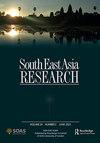描绘缅甸的转型
IF 0.9
3区 社会学
0 ASIAN STUDIES
引用次数: 1
摘要
(91),但不知何故,对古老智慧的记忆(15)是自相矛盾的,第一种说法可能是不正确的。在sukhaduh清单中的一些项目中可以看到先例 khas(“欢乐和悲伤”,需要法律调查和补救的不当行为和事故)早在九世纪就出现在古爪哇宪章中。霍德利在附录四“多样化的组成部分”中对这些章程作了一些不系统的评论。此外,一些可能比霍德利所讨论的更早的古爪哇法律文本定义了法律的技术术语,包括一些类似于霍德利的slokas的较长表达,其公式以n结尾 aranya(或其中爪哇语的等价物arane),意思是“它的名字是…,它被称为…”——霍德利实际上暗示了这种做法(170-72)。事实上,《库特法案》第66条中如此指定(并解释)的“卧床不起的尸体”āra Mānava(霍德利的“阿加玛”)和类似的文本也出现在铭文的列表中。《Púrvādhigamaāsana》是一部未出版的古爪哇作品,详细描述了湿婆神牧师的权利和特权,它解释了七种斯洛卡式的表达方式,这些表达方式指定了各种各样的作恶者,牧师有权向他们提供庇护——也就是说,牧师的财产可能构成“敞开的寺庙大门” ā)。其中一个表达方式,celen 在现代爪哇语表达ngadhepi cèlèng boloten(Suwarno 1999220)中,“死猪”(“irty pig”)以类似的配价出现(指习惯性的欺骗)。这些例子表明,文本形式的“懒虫现象”的历史比18世纪还要久远,要彻底了解早期现代爪哇法律概念和实践,需要对更古老的来源进行更全面的调查。它还要求以本卷所缺乏的语文敏锐性和历史敏感性来对待这些资料。因此,尽管霍德利在法律史上发现了一个引人入胜的重要话题,但这本书有几个严重的缺陷和局限性,应该谨慎查阅。本文章由计算机程序翻译,如有差异,请以英文原文为准。
Painting Myanmar’s transition
(91) and yet somehow a memory of older wisdom (15) is paradoxical, and the first claim is probably incorrect. A precedent can be seen in some of the items included in lists of sukhaduh khas (‘joys and sorrows’, misdeeds and accidents requiring legal inquiry and remedy) that appear in Old Javanese charters from as early as the ninth century. Hoadley makes some unsystematic remarks on such charters in Appendix IV: ‘Diverse Components’. In addition, several Old Javanese legal texts likely older than those discussed by Hoadley define technical terms of law, including some longer expressions resembling Hoadley’s slokas, in formulas ending in n aranya (or its Middle Javanese equivalent arane), meaning ‘its name is... , it is called... ’ – a practice to which Hoadley in fact alludes (170–72). Indeed, ‘the bedewed corpse’ so designated (and explained) in section 66 of the Kutāra Mānava (Hoadley’s ‘Agama’) and similar texts also appears in the lists in the inscriptions. The Pūrvādhigama Śāsana, an unpublished Old Javanese work detailing the rights and privileges of Śaiva priests, explains seven sloka-type expressions that designate various sorts of wrong-doer, to whom the priests are entitled to offer asylum – that is, the priests’ properties may constitute ‘open temple-gates’ (gopura mən ā). One of these expressions, celen bolotən (‘dirty pig’), appears with similar valence (to refer to a habitual cheat) in the modern Javanese expression ngadhepi cèlèng boloten (Suwarno 1999, 220). These examples show that thehistory of the ‘slokaphenomenon’ in textual form ismucholder than the eighteenth century, and that a thorough account of early modern Javanese legal concepts and practices requires a fuller investigation of older sources. It also requires that those sources be treated with philological acumen and historical sensitivity that are lacking in this volume. Hence, although Hoadley has identified a fascinating and important topic in legal history, the book has several serious flaws and limitations, and should be consultedwith caution.
求助全文
通过发布文献求助,成功后即可免费获取论文全文。
去求助
来源期刊

South East Asia Research
ASIAN STUDIES-
CiteScore
1.90
自引率
0.00%
发文量
42
期刊介绍:
Published three times per year by IP Publishing on behalf of SOAS (increasing to quarterly in 2010), South East Asia Research includes papers on all aspects of South East Asia within the disciplines of archaeology, art history, economics, geography, history, language and literature, law, music, political science, social anthropology and religious studies. Papers are based on original research or field work.
 求助内容:
求助内容: 应助结果提醒方式:
应助结果提醒方式:


